Ctenosaura
Ctenosaura is a lizard genus commonly known as spinytail iguanas or ctenosaurs. The genus is part of the large lizard family, Iguanidae and is native to Mexico and Central America. The name is derived from two Greek words: κτενός (ctenos), meaning "comb" (referring to the comblike spines on the lizard's back and tail), and σαύρα (saura), meaning "lizard".
| Ctenosaura | |
|---|---|
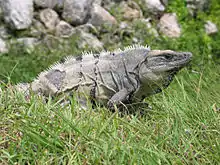 | |
| Spinytail iguana in Mexico | |
| Scientific classification | |
| Domain: | Eukaryota |
| Kingdom: | Animalia |
| Phylum: | Chordata |
| Class: | Reptilia |
| Order: | Squamata |
| Suborder: | Iguania |
| Family: | Iguanidae |
| Genus: | Ctenosaura Wiegmann, 1828 |
| Type species | |
| Ctenosaura acanthura | |

Description
The species range in size (total length, including the tail) from about 12.5 centimetres (4.9 in) to well over 1 metre (39 in). The distinctive feature of this genus is the presence of enlarged, spiny scales on the tail.
Ecology and natural history
Ctenosaurs are generally omnivorous, feeding on fruits, flowers, foliage, and small animals.
While studying physiological correlates of locomotion in lizards, a "burst speed" of 34.6 km/h (21.5 miles/h) was recorded by a black spiny-tail iguana (Ctenosaura similis), which is the highest speed reported for a lizard.[1]: p.812 [2]
Captivity
C. pectinata, C. similis, and C. quinquecarinata are popular as pets.
Invasive species
At least two species, Ctenosaura pectinata and Ctenosaura similis, have been introduced into southern areas of Texas and Florida. They are also now in southern Arizona.
Species
The genus Ctenosaura represents the most diverse group of iguanas with 15 currently recognized species and at least two unrecognized species.[3][4] These species inhabit lowland dry forests, woodlands and semi-open habitats, below 1,200 metres (3,900 ft) elevation, on both coasts of Mexico and Central America.[3] The species in the genus Ctenosaura belong in several different clades.[3] Closely related species show allopatry whereas species from divergent clades show sympatry.[3] Until 2017, the two species of Cachryx were included in Ctenosaura.[5]
| Image | Species | Common name | Authority | Geographic range |
|---|---|---|---|---|
 |
Ctenosaura acanthura | Mexican spiny-tailed iguana[6] | (Shaw, 1802)[7] | Eastern Mexico |
 |
Ctenosaura bakeri | Baker's spinytail iguana | Stejneger, 1901[8] | Utila island off Honduras |
| Ctenosaura clarki | Michoacan club tail [6] | Bailey, 1928[9] | Western Mexico | |
| Ctenosaura conspicuosa | Isla San Esteban spiny-tailed iguana [6] | Dickerson, 1919[10] | San Esteban Island, Gulf of California | |
| Ctenosaura flavidorsalis | yellowback spinytail iguana | G. Köhler & Klemmer, 1994 | Honduras, El Salvador, and Guatemala | |
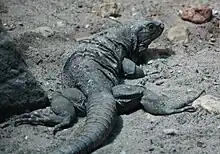 |
Ctenosaura hemilopha | cape spiny-tail iguana [6] | (Cope, 1863)[11] | Southern half of Baja California, Mexico |
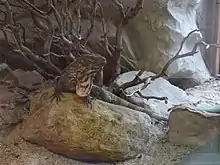 |
Ctenosaura macrolopha | Sonora spiny-tailed iguana [6] | Smith, H. M. 1972[12] | Sonora, Mexico |
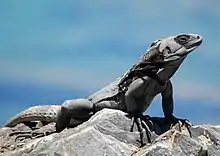 |
Ctenosaura melanosterna | black-chested spinytail iguana | Buckley & Axtell, 1997 | Honduras |
| Ctenosaura nolascensis | Isla San Pedro Nolasco spiny-tailed iguana [6] | Smith, H. M. 1972[12] | San Pedro Nolasco Island, Gulf of California | |
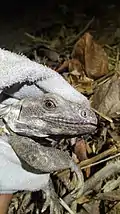 |
Ctenosaura oaxacana | Oaxacan spiny-tail iguana [6] | G. Köhler & Hasbún, 2001[13] | Oaxaca, Mexico |
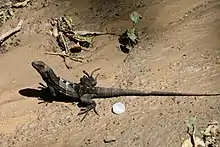 |
Ctenosaura oedirhina | Roatán spinytail iguana | de Queiroz, 1987 | Roatán, Honduras |
 |
Ctenosaura palearis | Guatemalan spinytail iguana | Stejneger, 1899 | Guatemala |
 |
Ctenosaura pectinata | western spiny-tail iguana [6] | (Wiegmann, 1834)[14] | Western Mexico. Introduced to southern areas of Texas and Florida. |
 |
Ctenosaura quinquecarinata | club tail iguana | Gray, 1842[15] | Nicaragua and Costa Rica. |
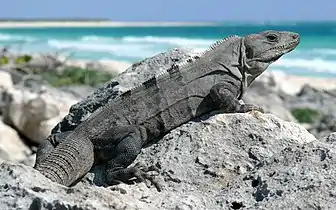 |
Ctenosaura similis | black spiny-tail iguana [6] | (Gray, 1831)[16] | Mexico and Central America; reported in some Colombian islands, introduced to southern Florida. |
References
- Garland, Theodore., Jr. 1984. Physiological correlates of locomotory performance in a lizard: an allometric approach. American Journal of Physiology. 247: 806–815.
- Malfatti, Mark (2007), "A Look at the Genus Ctenosaura: Meet the World's fastest lizard and its kin", Reptiles Magazine, 15 (11): 64–73
- Buckley, Larry; Pagel, Katelyn; Villela, Oscar (2007). "Evolution of Spiny-tailed Iguanas (Genus Ctenosaura): How Identification of Species Groups and their Relationships Can Help with Conservation Priorities". Iguana: Journal of the International Iguana Society. 14 (4): 248–251.
- "Ctenosaura ". Integrated Taxonomic Information System. Retrieved 2 January 2008.
- Malone, C.L.; Reynoso, V.H.; Buckley, L. (2017). "Never judge an iguana by its spines: Systematics of the Yucatan spiny tailed iguana, Ctenosaura defensor (Cope, 1866)". Molecular Phylogenetics and Evolution. 115: 27–39. doi:10.1016/j.ympev.2017.07.010.
- Liner, E. A. and G. Casas-Andreu. 2008. Standard Spanish, English and scientific names of the amphibians and reptiles of Mexico Society for the Study Amphibians and Reptiles. Herpetological Circular 38: i-iv, 1-162. (pages 58-59)
- Shaw, G. 1802. General Zoology, or Systematic Natural History. Vol.3, part 2. G. Kearsley, Thomas Davison, London: 313-615.
- Stejneger, Leonhard 1901. On a new species of spiny-tailed iguana from Utilla Island, Honduras. Proc. US Natl. Mus. 23 (1217): 467-468
- Bailey, J. W. 1928. A revision of the lizards of the genus Ctenosaura. Proc. US Natl. Mus. 73 (2733): 1-55
- Dickerson, M. C. 1919. Diagnoses of Twenty-Three New Species and a New Genus of Lizards from Lower California. Bulletin of the American Museum of Natural History 41 (10): 461-477.
- Cope, E.D. 1863. Descriptions of new American Squamata in the Museum of the Smtihsonian Institution. Proc. Acad. Nat. Sci. Philadelphia 15 [1863]: 100-106
- Smith,H.M. 1972. The sonoran subspecies of the lizard Ctenosaura hemilopha. Great Basin Naturalist 32 (2): 104-111.
- Köhler, G. & C.R. Hasbun 2001. A new species of spiny-tailed iguana from Mexico formerly referred to Ctenosaura quinquecarinata (Gray 1842) (Reptilia, Squamata, Iguanidae). Senckenbergiana biologica 81: 257-267
- Wiegmann, A.F.A. 1834. Herpetologia Mexicana, seu descriptio amphibiorum novae hispaniae , quae itineribus comitis de Sack, Ferdinandi Deppe et Chr. Guil. Schiede im Museum Zoologicum Berolinense Pervenerunt. Pars prima, saurorum species. Berlin, Lüderitz, iv + 54 pp.
- Gray, J. E. 1842. Description of some new species of Reptiles, chiefly from the British Museum collection. Zoological Miscellany 2: 57-59.
- Gray, J. E. 1831 [1830]. A synopsis of the species of Class Reptilia. In: Griffith, E & E. Pidgeon: The animal kingdom arranged in conformity with its organisation by the Baron Cuvier with additional descriptions of all the species hither named, and of many before noticed. V Whittaker, Treacher and Co., London: 481 + 110 pp.
Further reading
- Frost DR, Etheridge RE (1989). "A Phylogenetic Analysis and Taxonomy of Iguanian Lizards (Reptilia: Squamata)". Univ. Kansas Mus. Nat. Hist. Misc. Publ. 81.
- Frost DR, Etheridge R, Janies D, Titus TA (2001). "Total evidence, sequence alignment, evolution of Polychrotid lizards, and a reclassification of the Iguania (Squamata: Iguania)". American Museum Novitates (3343): 1-38.
External links
- Genus Ctenosaura at The Reptile Database
- Garland T Jr (1984). "Physiological correlates of locomotory performance in a lizard: an allometric approach". American J. Physiol. 247 (Regulatory Integrative Comp. Physiol. 16): R806-R815. PDF
- IIF Announces Fundraising Campaign
- Spiny Tailed Iguana Pictures
- West Coast Iguana Research